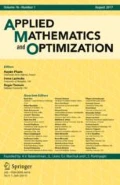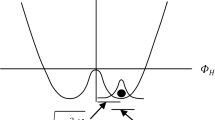Abstract
The main objectives of this article are to postulate a new principle of representation invariance (PRI), and to refine the unified field model of four interactions, derived using the principle of interaction dynamics (PID). Intuitively, PID takes the variation of the action functional under energy-momentum conservation constraint, and PRI requires that physical laws be independent of representations of the gauge groups. One important outcome of this unified field model is a natural duality between the interacting fields (g,A,W a,S k), corresponding to graviton, photon, intermediate vector bosons W ± and Z and gluons, and the adjoint bosonic fields \((\varPhi_{\mu}, \phi^{0}, \phi^{a}_{w}, \phi^{k}_{s})\). This duality predicts two Higgs particles of similar mass with one due to weak interaction and the other due to strong interaction. The unified field model can be naturally decoupled to study individual interactions, leading to (1) modified Einstein equations, giving rise to a unified theory for dark matter and dark energy (Ma and Wang in Discrete Contin. Dyn. Syst., Ser A. 34(2):335–366, 2014), (2) three levels of strong interaction potentials for quark, nucleon/hadron, and atom respectively (Ma and Wang in Duality theory of strong interaction, 2012), and (3) two weak interaction potentials (Ma and Wang in Duality theory of weak interaction, 2012). These potential/force formulas offer a clear mechanism for both quark confinement and asymptotic freedom—a longstanding problem in particle physics (Ma and Wang in Duality theory of strong interaction, 2012).
Similar content being viewed by others
References
Englert, F., Brout, R.: Broken symmetry and the mass of gauge vector mesons. Phys. Rev. Lett. 13(9), 321–323 (1964)
Glashow, S.: Gauge theories of vector particles. DOE technical report (1961)
Griffiths, D.: Introduction to Elementary Particles. Wiley-VCH, New York (2008)
Guralnik, G., Hagen, C.R., Kibble, T.W.B.: Global conservation laws and massless particles. Phys. Rev. Lett. 13(20), 585–587 (1964)
Halzen, F., Martin, A.D.: Quarks and Leptons: an Introductory Course in Modern Particle Physics. Wiley, New York (1984)
Higgs, P.W.: Broken symmetries and the masses of gauge bosons. Phys. Rev. Lett. 13, 508–509 (1964)
Kaku, M.: Quantum Field Theory, a Modern Introduction. Oxford University Press, London (1993)
Kane, G.: Modern Elementary Particle Physics vol. 2. Addison-Wesley, Reading (1987)
Ma, T., Wang, S.: Duality theory of strong interaction. Indiana University Institute for Scientific Computing and Applied Mathematics Preprint Series #1301 (2012). http://www.indiana.edu/~iscam/preprint/1301.pdf. See also: arXiv:1212.4893
Ma, T., Wang, S.: Duality theory of weak interaction. Indiana University Institute for Scientific Computing. and Applied Mathematics Preprint Series. #1302 (2012). http://www.indiana.edu/~iscam/preprint/1302.pdf. See also: arXiv:1212.4893
Ma, T., Wang, S.: Gravitational field equations and theory of dark matter and dark energy. Discrete Contin. Dyn. Syst., Ser. A 34(2), 335–366 (2014). See also arXiv:1206.5078
Ma, T., Wang, S.: Structure and stability of matter. Indiana University Institute for Scientific Computing and Applied Mathematics Preprint Series #1303 (2012). http://www.indiana.edu/~iscam/preprint/1303.pdf. See also: arXiv:1212.4893
Ma, T., Wang, S.: Unified field equations coupling four forces and principle of interaction dynamics. arXiv:1210.0448 (2012)
Ma, T., Wang, S.: Weakton model of elementary particles and decay mechanisms. Indiana University Institute for Scientific Computing and Applied Mathematics Preprint Series #1304 (May 30, 2013). http://www.indiana.edu/~iscam/preprint/1304.pdf. See also: arXiv:1212.4893
Nambu, Y.: Spontaneous symmetry breaking in particle physics: a case of cross fertilization (2008). http://www.nobelprize.org/nobel_prizes/physics/laureates/2008/nambu-slides.pdf
Quigg, C.: Gauge Theories of the Strong, Weak, and Electromagnetic Interactions. Benjamin/Cummings, Reading (1983)
Salam, A.: Elementary Particle Theory. Svaratholm, Stockholm (1968)
Weinberg, S.: A model of leptons. Phys. Rev. Lett. 19, 1264–1266 (1967)
Zhang, N.-S.: Particle Physics, vol. I & II. Chinese Academic Press, Beijing (1994). In Chinese
Author information
Authors and Affiliations
Corresponding author
Additional information
The authors are grateful for the referee’s insightful suggestions. The work was supported in part by the Office of Naval Research, by the US National Science Foundation, and by the Chinese National Science Foundation. This paper was first appeared as version 1 of arXiv:1212.4893.
Rights and permissions
About this article
Cite this article
Ma, T., Wang, S. Unified Field Theory and Principle of Representation Invariance. Appl Math Optim 69, 359–392 (2014). https://doi.org/10.1007/s00245-013-9226-0
Published:
Issue Date:
DOI: https://doi.org/10.1007/s00245-013-9226-0
Keywords
- Principle of Interaction Dynamics (PID)
- Principle of Representation Invariance (PRI)
- Unified field equations
- Duality theory of interactions
- Quark confinement
- Asymptotic freedom
- Higgs mechanism
- Higgs bosons
- Quark potential
- Nucleon potential
- Atom potential
- Weak interaction potential
- Strong interaction force formulas
- Weak interaction force formula
- Electroweak theory



